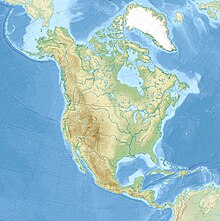Earth:Hannold Hill Formation
From HandWiki
| Hannold Hill Formation Stratigraphic range: Wasatchian 55.8–50 Ma | |
|---|---|
| Type | Geological formation |
| Unit of | Tornillo Group |
| Location | |
| Coordinates | [ ⚑ ] : 29°24′N 103°06′W / 29.4°N 103.1°W |
| Paleocoordinates | [ ⚑ ] 33°42′N 89°00′W / 33.7°N 89.0°W |
| Region | Texas |
| Country | |
| Type section | |
| Named for | Hannold Hill |
| Lua error in Module:Location_map/multi at line 27: Unable to find the specified location map definition: "Module:Location map/data/Texas" does not exist. | |
The Hannold Hill Formation is an Early Eocene (Wasatchian) geologic unit in the western United States.[1] It preserves the fossilized remains of the ray Myliobatis and gar.[2]
Fossil content
The following fossils have been reported from the formation:[1]
- Glires
- Pantodonta
- Caenolambda jepseni[3]
- Coryphodon armatus[4]
- Coryphodon sp.[5]
- Perissodactyla
- Hyracotherium vasacciense
- Minippus index[4]
- Placentalia
- Hyopsodus cf. wortmani[3]
- Hyopsodus sp.[4]
- Phenacodus sp.[4]
- Primates
- Phenacolemurinae indet.[4]
Wasatchian correlations
| Basin | Powder River Uinta Piceance Colorado Plateau Wind River Green River Bighorn |
Piceance |
Colorado Plateau |
Wind River |
Green River |
Bighorn |
Williston | Okanagan | Princeton | Buck Creek | Nechako | Sverdrup | Potomac | GoM | Laguna Salada | Rio Grande | North Park | Raton | Galisteo | San Juan | ||
|---|---|---|---|---|---|---|---|---|---|---|---|---|---|---|---|---|---|---|---|---|---|---|
| Country | ||||||||||||||||||||||
| Copelemur | 14px | 14px | 14px | 14px | ||||||||||||||||||
| Coryphodon | 14px | 14px | 14px | 14px | 14px | 14px | 14px | 14px | 14px | 14px | ||||||||||||
| Diacodexis | 14px | 14px | 14px | 14px | 14px | 14px | 14px | |||||||||||||||
| Homogalax | 14px | 14px | 14px | 14px | 14px | 14px | 14px | |||||||||||||||
| Oxyaena | 14px | 14px | 14px | 14px | 14px | |||||||||||||||||
| Paramys | 14px | 14px | 14px | 14px | 14px | 14px | 14px | 14px | 14px | |||||||||||||
| Primates | 10px | 10px | 10px | 10px | 10px | 10px | 10px | |||||||||||||||
| Birds | 10px | 10px | 10px | 10px | 10px | |||||||||||||||||
| Reptiles | 10px | 10px | 10px | 10px | 10px | 10px | 10px | |||||||||||||||
| Fish | 10px | 10px | 10px | 10px | 10px | 10px | 10px | |||||||||||||||
| Insects | 10px | 10px | 10px | 10px | 10px | 10px | ||||||||||||||||
| Flora | 10px | 10px | 10px | 10px | 10px | 10px | 10px | 10px | 10px | |||||||||||||
| Environments | Alluvial-fluvio-lacustrine | Fluvial | Fluvial | Fluvio-lacustrine | Fluvial | Lacustrine | Fluvio-lacustrine | Deltaic-paludal | Shallow marine | Fluvial | Shallow marine | Fluvial | Fluvial | 8px Wasatchian fauna | ||||||||
| Volcanic | Yes | No | Yes | No | Yes | No | Yes | No | Yes | No | ||||||||||||
References
Bibliography
- Hunt, ReBecca K., Vincent L. Santucci and Jason Kenworthy. 2006. "A preliminary inventory of fossil fish from National Park Service units." in S.G. Lucas, J.A. Spielmann, P.M. Hester, J.P. Kenworthy, and V.L. Santucci (ed.s), Fossils from Federal Lands. New Mexico Museum of Natural History and Science Bulletin 34, pp. 63–69
- Alroy, J. 2002. Synonymies and reidentifications of North American fossil mammals, .. _.
- Lucas, S. G. 1989. Coryphodon (Mammalia, Pantodonta) from the Hannold Hill Formation, Eocene of Trans-Pecos Texas. Pearce-Sellards Series 46. ..
- J. A. Schiebout and Et al. 1987. Stratigraphy of the Cretaceous-Tertiary and Paleocene-Eocene Transition Rocks of Big Bend National Park, Texas . Journal of Geology 95
- J. A. Wilson. 1967. Early Tertiary mammals. In R. A. Maxwell, J. T. Lonsdale, R. T. Hazzard, & J. A. Wilson (eds.), Geology of Big Bend National Park, Brewster County, Texas. The University of Texas Publication 6711:157-169
 |


